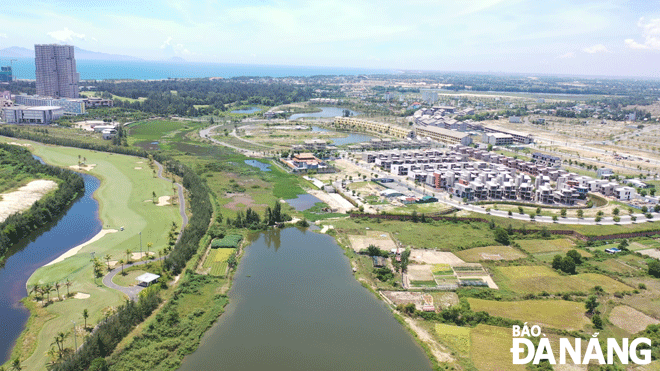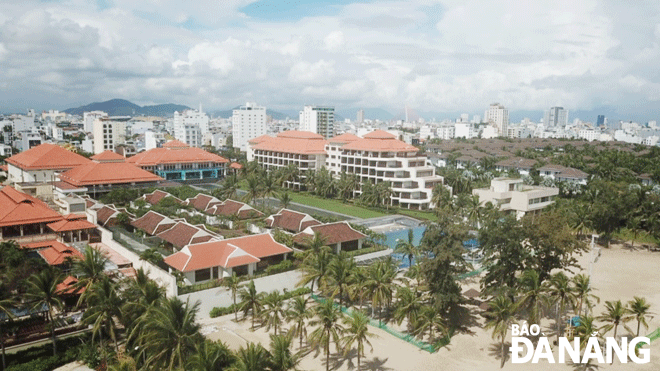Da Nang plays nuclear role in central key economic zone
The key economic zone in Central Viet Nam comprises Thua Thien Hue, Da Nang, Quang Nam, Quang Ngai and Binh Dinh. Till date, the regional economic development linkage is gradually taking shape, in which, Da Nang is affirming its nuclear role.
 |
| The urban space of Da Nang is expanded to the south to create development linkages with Quang Nam Province. IN THE PHOTO: An urban area along the Co Co River is seen from above. Photo: TRIEU TUNG |
Developing regional linkage
The Central Key Economic Zone Council was officially established on November 24, 2015 with its members being Chairmen of the People's Committees of 5 provinces and cities in Central Viet Nam.
Accordingly, the chairperson of the council is elected alternately in 5 provinces and cities in the region, creating a legal basis for the coordination between the central and local governments in the zone to ensure consistency in national policy formulation and implementation.
This zone holds a particularly important position in the socio-economic development strategy and ensures national defence and security for both the Central Coast and the Central Highlands, serving as an important bridge in boosting economic and cultural exchanges with the world.
Besides, this zone is an important transshipment point for goods with the Central Highlands provinces and the most convenient gateway to the sea for localities in southern Laos, northeast Thailand and northeast Cambodia through the East-West Economic Corridor.
In recent years, with the support of the authorities at all levels, the zone has made efforts to promote its socio-economic development, with a focus on developing coordination mechanisms and linkage policies between localities in the zone and other regions.
According to a report released on June 30, 2022 by the Centre for Economic Analysis and Forecasting, the average growth rate of GRDP in the zone was always maintained at high growth rate of 10.25% per year during the 2001-2019 period.
In the 2011-2019 period, the zone’s growth rate decreased significantly compared to the previous period to reach at 8.14% per year, but was still higher than the average growth rate of the whole country at 6.2% per year.
The five localities in the zone maintained a high growth rate. Specifically, Da Nang recorded the highest economic growth rate of 12.05% per year in the region, followed by Quang Nam Province with an average growth rate of 11.58% per year.
Quang Nam Province maintains a high growth rate for a long time thanks to the important role of the Chu Lai Open Economic Zone. In particular, the Chu Lai Truong Hai Automobile Complex greatly contributes to promoting the development of Viet Nam's auto mechanics industry, creating a number of high-value industrial products that can participate in the global value chain.
Meanwhile, Quang Ngai Province achieves a relatively high economic growth rate for a long time at 11.19% per year, thanks to the great contribution of the Dung Quat Oil Refinery since 2009. Binh Dinh Province records a growth rate of about 8 ,73% per year.
The linkage in regional development is reflected in the fact that localities have actively coordinated with ministries and branches to promote sub-regional and regional development cooperation in 6 key areas.
Specifically, importance has been attached to organising investment promotion conferences, mobilising foreign investment capital such as FDI and ODA, encouraging domestic investors to invest into localities in the region, training human resources, and building database of regional information system.
Furthermore, the provinces and cities have organised many seminars, conferences and briefings to assess the current situation and discuss solutions on regional development linkages.
The Zone Council has rotated meetings in Da Nang and Thua Thien Hue Province, as well as has issued a number of resolutions and plans for regional linkage and development for each period in order to well perform the role of coordinating regional activities in the zone.
 |
| The urban development planning helps to ensure the infrastructure for the city's socio-economic development, thereby promoting the progress of the central key economic zone. IN THE PHOTO: A corner of Da Nang. Photo: TRIEU TUNG |
Da Nang promotes its nuclear role in the zone
Over the past time, Da Nang’s economy has maintained a good growth rate, and its economic structure has shifted in the right direction with tourism beoming a spearhead economic sector.
Moreover, the city boasts its international competitiveness, open and transparent investment environment, and expanded external activities. Also, the indicators of local attractiveness, competitiveness, and human development indexes are always maintained in the group of leading localities in the country.
Da Nang has become one of the cities with high growth rates in the country as it recorded an average growth rate of 7.66% per year during the 2005-2021 period. As of 2021, the city’s GRDP scale was estimated to exceed VND 105,000 billion.
According to Deputy Head of the Party Central Committee's Economic Commission Nguyen Hong Son, with many breakthrough and creative ways, Da Nang has achieved comprehensive results, and the face of Da Nang has completely changed.
Da Nang has become a dynamic and worth-living city, a growth pole and the centre of the Central Key Economic Zone.
Notably, Da Nang is the first locality to initiate the development of linkage and cooperation between localities in the zone, of which Da Nang is a founding member of the cooperation and development model in the zone on a voluntary basis which receives active support by many localities in the region, and is recognised and appreciated by central agencies.
Reporting by TRIEU TUNG - Translating by M.DUNG